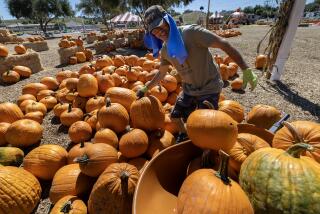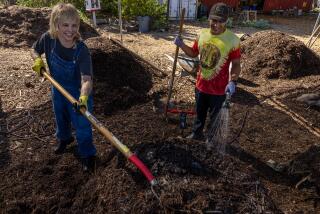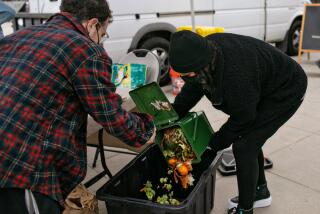GARDENING : Compost, Because a Rind Is a Terrible Thing to Waste
- Share via
Compostable materials--leaves, grass and food waste--are your biggest contribution to the local landfill after paper.
Yard waste makes up 17% and food waste makes up 8% of our landfills--a total of one-fourth of all our trash.
Composting this material in your back yard, however, will shrink your garbage output, reduce the volume of the materials and give you a valuable soil amendment that provides good drainage and moisture retention for your lawn or garden. All you need to start composting is a little space and patience. If you want to make the most of your compost pile and avoid some deleterious side effects, however, there are some do’s and don’ts to follow.
Do
* Turn the pile. For the best results, turn the pile with a pitchfork about once a week. This provides the oxygen necessary to the composting process. If you leave your yard waste and food scraps in an unturned pile, they will eventually rot, but it may take a year or two.
* Throw in a variety of items. Leaves or grass by themselves lack the nitrogen to put composting bacteria to work. Add fresh leafy greens, kitchen produce scraps, manure or specialized compost starters that you buy.
* Water the pile. A compost pile should be moist, not soggy or dry. During dry periods, add a little water to the pile; or cover the pile with a tarp to retain moisture and increase the pile’s humidity. The presence of white, lacy fungi indicates that your pile is too dry.
* Chip or shred woody material. Bark and small tree branches are difficult to compost. Run them through a shredder or chipper first.
Don’t:
* Throw in meat, bones, fat or grease. These can turn rancid and attract vermin and wild animals.
* Put your pile too close to the house. Don’t put it close to your neighbor’s either. Food scraps will draw flies. And odors may result if the pile is turned infrequently.
*
The ideal size to build a compost pile is about three feet square and waist high. Any smaller and you won’t get a vigorous composting action. Too much larger and you may have uneven spots or difficulty turning the pile.
Use chicken wire or boards with slats in them to get air into the pile. A gate or opening on the front will make the turning easier.
Most store-bought compost bins offer some sort of specialized convenience. They can be portable, washable or insulated. Some offer double chambers or tumblers for easy turning. On a small lot or where neighbors are close by, use a small, closed container.
The best uses for compost are in the garden. Mix it in with your soil, and it will break up clay, hold moisture and encourage the growth of friendly bacteria. You can also spread a thin layer of compost on your lawn.






